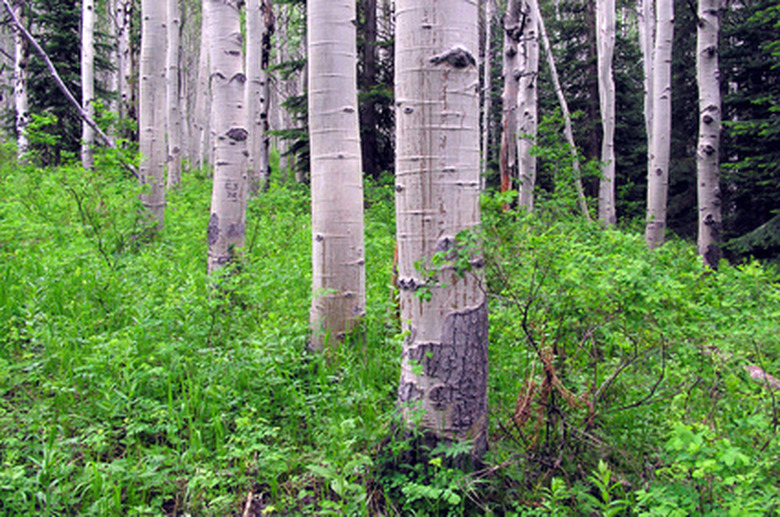Difference Between A Birch Tree & An Aspen Tree
Birch trees, of the genus Betula, are quite different than aspen trees, of the genus Populus. Both trees have the capability of growing to around the same height, and both share bright fall foliage. The color of the autumn leaves and the general height of these trees is where the similarities end, as there are many differences between birch trees and aspen trees.
Bark Appearance
Birch tree bark is marked with horizontal lenticels, or cellular clumps that act as pores on the tree. The color of the bark may be gray, grayish white, grayish red or grayish black. Because of the marking caused by the lenticels, the papery bark of birch trees easily flakes and peels off of the trunks of the trees. The bark of aspen trees is smooth and white, marked only occasionally by stark black knots or scarring.
- Birch trees, of the genus Betula, are quite different than aspen trees, of the genus Populus.
- The bark of aspen trees is smooth and white, marked only occasionally by stark black knots or scarring.
Leaf Appearance
Regardless of the species of birch, the leaves appear the same. Birch leaves are alternate in their arrangement on the twig. They are doubly serrate, meaning the edges of the leaves resemble the blade of a saw, with larger "saw teeth" interspersed among smaller ones. Birch leaves have a fine network veins running through them, stemming from a single, central vein. Birch leaves have leaf stems, called petioles, with a rounded stipule, or bump where the leaf attaches to the twig.
Aspen leaves are almost perfectly round. While not serrated, the leaf margins of aspen leaves are marked by rounded teeth, resembling tiny bumps along the edge. The petioles of aspen leaves are flat and alternately arranged along the twig.
- Regardless of the species of birch, the leaves appear the same.
- Birch leaves have leaf stems, called petioles, with a rounded stipule, or bump where the leaf attaches to the twig.
Buds
Before leaves ever appear, they begin as buds on the ends of branches. During the winter, scars where these buds existed in previous years can give a clue to the identification of a tree without any leaves present.
Birch tree buds form in the early spring and are fully grown by the beginning to middle of summer. Buds are arranged laterally on the tree, and branches do not have terminal buds. The buds are reddish-purple in color and shaped like cones.
Aspen buds are reddish-brown in color. Aspen tree buds are conical, like those of a birch tree, differing in that aspen trees form terminal buds. Aspen buds usually form later in the season than birch buds, requiring less time to mature. The bud scars are more prominent against the white bark of the tree.
- Before leaves ever appear, they begin as buds on the ends of branches.
- Aspen tree buds are conical, like those of a birch tree, differing in that aspen trees form terminal buds.
Climate and Location
Aspen trees are restricted to USDA cold hardiness zones 1 through 6, with trees in warmer and considerably colder climates becoming dwarfed. Birch trees generally grow best in USDA cold hardiness zones 6 through 3, but can tolerate warmer and colder climates with only a little difficulty. Aspen trees are found across the North American continent from Canada down to Mexico, while birch trees are generally only found in the eastern United States and parts of Canada.
Growth Requirements
Birch trees thrive in partial sunlight, while aspen trees require full sun. Birch trees require loosely packed soil to accommodate their shallow root systems, while aspen trees tolerate a variety of soil conditions.
References
- "Trees, Shrubs, and Vines of Southeastern Ohio;" William Perine, Dennis Profant; 1993
- "National Wildlife Federation Field Guide to Trees of North America"; Bruce Kershner, Craig Tufts, Daniel Mathews, Gil Nelson; 2008
- "Taylor's Encyclopedia of Garden Plants: The Most Authoritative Guide to the Best Flowers, Trees, and Shrubs for North American Gardens;" Frances Tenenbaum; 2003
- " What Tree Is That?"; Arbor Day Foundation; 2009
- "Trees of North America: A Guide to Field Identification, Revised and Updated;" C. Frank Brockman, Rebecca Marrilees; 2001
